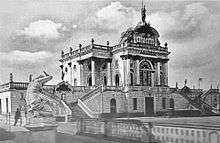Avenida Reforma
 Aerial view of Avenida Reforma in 2016 | |
| Former name(s) | Boulevard 30 de Junio, Boulevard Reformador, Boulevard La Reforma, Paseo La Reforma |
|---|---|
| Namesake | Justo Rufino Barrios, known as El Reformador |
| Length | 2.26 km[1] (1.40 mi) |
| Location | Guatemala City, Guatemala |
| Coordinates | 14°36′19″N 90°30′57″W / 14.6053°N 90.5158°WCoordinates: 14°36′19″N 90°30′57″W / 14.6053°N 90.5158°W |
| North end | Obelisco |
| Construction | |
| Construction start | 1892 |
| Inauguration | 1895 |
Avenida Reforma ("Reform Avenue") is a main boulevard in the east-center part of Guatemala City, the capital of Guatemala. It is considered one of the main, if not the most important thoroughfare of Guatemala City. It passes through some of the richest areas of the city, and it is considered a highly desirable location to reside in. It and the surrounding part of Guatemala city are considered as the "Modern Downtown", giving reference to Zone 1, being the "Historic Center", which was as the name says, the original Spanish colonial area in the city. It's a little over 2 km (1 mi) in length, and has an average width of 60 meters (197 ft) from sidewalk to sidewalk, only getting a bit narrower at its northernmost part, before merging with five other streets, in a roundabout southeast of Zone 4.
Running from north to south, it connects the northern areas of the city (Zone 4, Zone 5, both of them serving as the gateway to Avenida Reforma for Zone 1) with the southern districts (Southern tip of Zone 4, Zone 9, Zone 10 subsequently as Avenida Las Americas divides both Zone 13 and Zone 14)and divides zone 9 from zone 10.
It features a broad park-like median, lined with trees and monuments. With the years the boulevard became one of the finest addresses in the city. Adjacent, the Zona Viva and multiple modern buildings can be found. Older buildings are the polytechnical school and some private villas. The southern end is at the Obelisco, where it is continued by Avenida Las Americas.
History

The Avenida Reforma was originally known as Boulevard 30 de Junio (June 30th), to commemorate the victory of the liberal forces of Miguel García Granados and Justo Rufino Barrios. Construction started in 1892, and it was inaugurated in 1895 under president José María Reina Barrios.[2] Its design was inspired by the Champs Elysées in Paris. President Reina Barrios had wanted to showcase Guatemala's economic boom for the 1897 Central American Expo; drawing inspiration from the Champs Elysées in Paris, he commissioned several sculptures and fountains from foreign artists. He also commissioned the Palacio de la Reforma, a French style palace that was located at the southern end of the boulevard and served as a museum. Incidentally, these expenses, among other reasons, caused an economic crisis in the country.[1]

The 1917-1918 earthquakes destroyed many of the buildings along the boulevard, including the Reforma Palace. Only a few buildings from that time, such as the Escuela Politécnica (Guatemala's military academy), remain. The southern end of the Avenida Reforma remained empty until 1935, when the Obelisco was built.[1] Throughout the years, the Avenida Reforma has had several names; from its original name of Boulevard 30 de Junio it changed to Boulevard Reformador, then to Boulevard La Reforma, Paseo La Reforma, and its current name of Avenida Reforma.[2]
References
- 1 2 3 "Avenida de La Reforma". Municipalidad de Guatemala (in Spanish). Retrieved 8 August 2017.
- 1 2 "Historia de la Avenida Reforma en Guatemala". Aprende Guatemala.com (in Spanish). 20 March 2017. Retrieved 8 August 2017.
| Wikimedia Commons has media related to Avenida La Reforma, Guatemala City. |